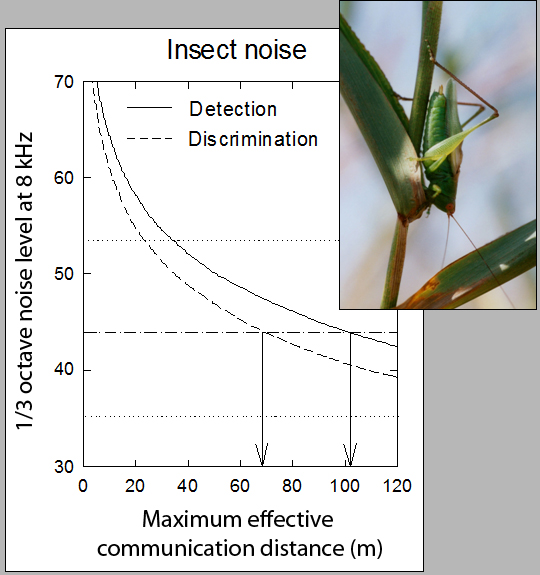
The active space of a signal
We are interested in modeling the distances over which songbirds can detect, discriminate, and recognize conspecific communication signals. These studies involve a combination of audio recording, noise measurements, estimates of bird densities (at the population level), and measurement of territory boundaries using GPS/GIS technology. Noise is ubiquitous in many natural and anthropogenic environments, and can have a strong impact on animals communicating acoustically. In the past decade there has been a rapidly growing interest in research focused on the masking effects of noise. The goal of our work is to combine habitat bioacoustics and geographic measures with auditory data obtained in the laboratory to develop a theoretical basis for predicting reliable auditory limits and effective communication distances in the field. Such data are also of keen interest in an applied sense. They are instrumental in estimating acceptable habitat noise levels for birds, and also in providing auditory models for human listeners doing acoustic bird surveys.

Grasshopper Sparrow song variation
Grasshopper Sparrows produce two distinct song types, the territorial "buzz" song, sung by unpaired males and by paired males early in each breeding cycle, and the "warble" song, sung only by paired males, typically later in each breeding cycle. We are investigating variation among populations and subspecies in each of these two song types. Each male produces a single version of each song (there are no differences in repertoire between males). And each male's songs are unique (there is no local dialect). As some subspecies are migratory and some are sedentary, Grasshopper Sparrows provide an interesting model for examining song similarity among neighbors under both conditions. We have recently expanded our analysis of variation in the four North American subspecies into the Caribbean with recordings of birds in Puerto Rico and (soon) in Jamaica, each with its own sedentary subspecies.

Grasshopper Sparrow breeding behavior
See our page on Funding and Conservation Biology for more information on our captive breeding program, and our studies of the applications of behavior to conservation biology.
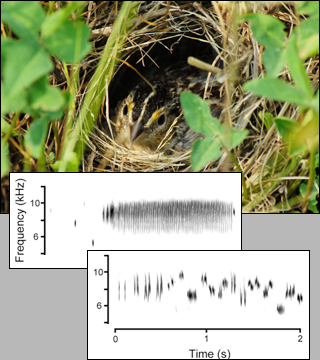
Sexual selection and birdsong
Recent proposals about how sexual selection acts on birdsong suggest that song performance (how physically demanding a song is to sing) and song output (the rate and total number of songs sung), may play an important role in female choice and male reproductive success. Our population of Grasshopper Sparrows (Ammodramus savannarum) at the Chester River Field Research Station provides a unique site for testing these predictions. A high rate of extra-pair mating (40 - 50%) combined with 10 - 15% return rate of males born in the study area (very high for first-year migratory songbirds) allows us to contrast genetic versus cultural influences on song. We can compare songs of sons to those of both their social and genetic fathers. Grasshopper sparrows sing a single individually distinctive territorial ("buzz") song that is likely near the performance limits of small birds for at least two measurable song characters. Our use of autonomous recording units (ARUs) at the site has made recording total song output of territorial males feasible. This technology, in combination with our species and study system, will allow us to contrast song output with song performance as potential honest signals in the context of sexual selection and female choice.
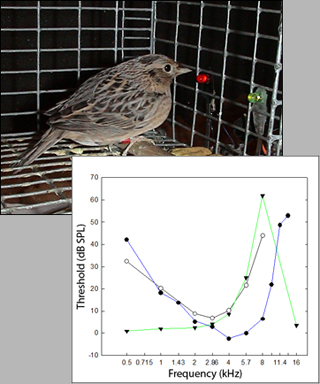
Comparative hearing in birds
Hearing in birds is remarkably uniform. Only owls and a few other species show markedly different auditory abilities from the typical small bird. I am interested in whether this uniformity is a by-product of the small group of generally related birds tested to date (approximately 50 species), or whether it represents a more pervasive trend among bird taxa. Candidate species for more comparative work are those having anatomical distinctions from small passerines (woodpeckers), those at a size extreme (hummingbirds) or those with unusual vocal characteristics (some Ammodramus sparrows). My students and I have been using basic auditory sensitivity measures (such as the audiogram and critical ratio function), along with anatomical and physiological data (ABR evoked potential studies), to examine the plasticity of auditory sensitivities among small passerines and non-passerines.
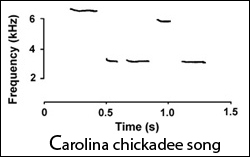
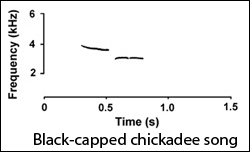
Music psychology as a tool for understanding song recognition in birds
Acoustic frequency (pitch) information can play an important role in identifying competitors for mates and territory. Several principles applied most commonly in the perception of music in humans are also applicable in birdsong recognition. The perception of musical pitch can be divided into two broad categories: relative and absolute. Relative frequency perception involves the ability to recognize relationships between note frequencies, while absolute frequency perception involves identifying the frequency of individual song notes without an external reference. Several species of North American chickadees sing very simple songs, consisting principally of unmodulated pure tones, providing an excellent model system for understanding frequency perception in birds. Song playback studies have shown that in Carolina Chickadees (Poecile carolinensis), the absolute frequencies of high and low frequency notes provide the primary cues for song recognition, while transitional sequences (contours) between notes play a supplementary role. Two other species, Black-capped Chickadees (P. atricapillus) and Mountain Chickadees (P. gambeli), are sympatric over parts of their geographic ranges, and they may sing very similar songs. An examination of variation in song, combined with preliminary playback studies suggest that absolute frequency cues predominate again, in this case as a means of differentiating conspecific from very similar heterospecific songs.